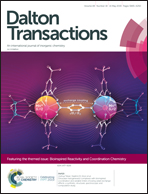Heteronuclear d–d and d–f Ru(ii)/M complexes [M = Gd(iii), Yb(iii), Nd(iii), Zn(ii) or Mn(ii)] of ligands combining phenanthroline and aminocarboxylate binding sites: combined relaxivity, cell imaging and photophysical studies†
Abstract
A ligand skeleton combining a 1,10-phenanthroline (phen) binding site and one or two heptadentate N3O4 aminocarboxylate binding sites, connected via alkyne spacers to the phen C3 or C3/C8 positions, has been used to prepare a range of heteronuclear Ru·M and Ru·M2 complexes which have been evaluated for their cell imaging, relaxivity, and photophysical properties. In all cases the phen unit is bound to a {Ru(bipy)2}2+ unit to give a phosphorescent {Ru(bipy)2(phen)}2+ luminophore, and the pendant aminocarboxylate sites are occupied by a secondary metal ion M which is either a lanthanide [Gd(III), Nd(III), Yb(III)] or another d-block ion [Zn(II), Mn(II)]. When M = Gd(III) or Mn(II) these ions provide the complexes with a high relaxivity for water; in the case of Ru·Gd and Ru·Gd2 the combination of high water relaxivity and 3MLCT phosphorescence from the Ru(II) unit provides the possibility of two different types of imaging modality in a single molecular probe. In the case of Ru·Mn and Ru·Mn2 the Ru(II)-based phosphorescence is substantially reduced compared to the control complexes Ru·Zn and Ru·Zn2 due to the quenching effect of the Mn(II) centres. Ultrafast transient absorption spectroscopy studies on Ru·Mn (and Ru·Zn as a non-quenched control) reveal the occurrence of fast (<1 ns) PET in Ru·Mn, from the Mn(II) ion to the Ru(II)-based 3MLCT state, i.e. MnII–(phen˙−)–RuIII → MnIII–(phen˙−)–RuII; the resulting MnIII–(phen˙−) state decays with τ ≈ 5 ns and is non-luminescent. This occurs in conformers when an ET pathway is facilitated by a planar, conjugated bridging ligand conformation connecting the two units across the alkyne bridge but does not occur in conformers where the two units are electronically decoupled by a twisted conformation of the bridging ligand. Computational studies (DFT) on Ru·Mn confirmed both the occurrence of the PET quenching pathway and its dependence on molecular conformation. In the complexes Ru·Ln and Ru·Ln2 (Ln = Nd, Yb), sensitised near-infrared luminescence from Nd(III) or Yb(III) is observed following photoinduced energy-transfer from the Ru(II) core, with Ru → Nd energy-transfer being faster than Ru → Yb energy-transfer due to the higher density of energy-accepting states on Nd(III).
![Graphical abstract: Heteronuclear d–d and d–f Ru(ii)/M complexes [M = Gd(iii), Yb(iii), Nd(iii), Zn(ii) or Mn(ii)] of ligands combining phenanthroline and aminocarboxylate binding sites: combined relaxivity, cell imaging and photophysical studies](/en/Image/Get?imageInfo.ImageType=GA&imageInfo.ImageIdentifier.ManuscriptID=C9DT00954J&imageInfo.ImageIdentifier.Year=2019)


 Please wait while we load your content...
Please wait while we load your content...